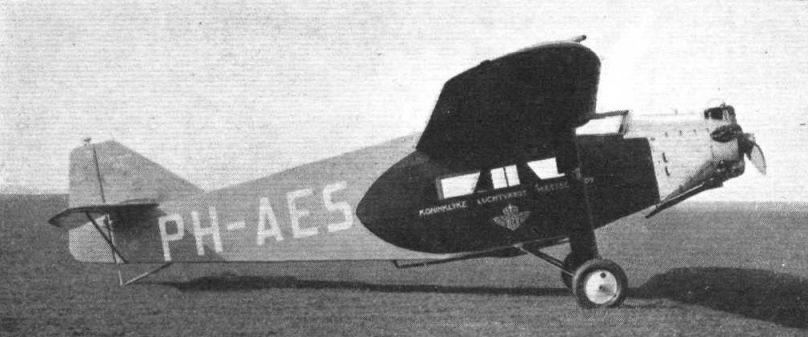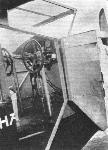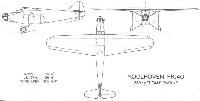Jane's Encyclopedia of Aviation
Koolhoven F.K.40 (Netherlands)
Four-six-seat cabin monoplane powered by a 171.4 kW (230 hp) Gnome-Rhone Titan or 223.5 kW (300 hp) Pratt & Whitney Wasp Junior engine. Operated by KLM.
Показать полностьюShow all
Flight, February 1930
THE KOOLHOVEN F.K.40
WITH a strong "family resemblance" to the Koolhoven F.K.41, now become the Desoutter Sports Coupe, the Koolhoven F.K.40 is of somewhat higher power and has a greater fuselage space, so that it can be used variously as a "feeder line" passenger machine, as a freight or mail carrier, or as a private touring machine with spacious seating accommodation for three passengers exclusive of pilot. As distinct from the smaller machine, however, the F.K.40 has a welded steel tube fuselage.
The photograph at the top of this page shows the first machine delivered by Mr. Koolhoven to the K.L.M. Royal Dutch Air Lines, and has an accommodation arrangement which is not standard. Actually the F.K. 40 may be said to have been designed as a civilian "General Purpose" machine, the internal accommodation being varied to suit the particular purpose. For instance, when the machine is to be used as a passenger-carrier, it can be fitted out with 4 seats for passengers, and with two seats side by side for pilot and assistant pilot. In this case a luggage compartment is provided aft of the saloon.
Should the machine be required for freight or mail carrying, the cabin can be boarded up, leaving a freight or mail space of some 190 cub. ft. In this case it is suggested that a single seat be provided for one pilot only.
Finally, the layout can be so arranged that there is a pilot's single seat, centrally placed ahead of the cabin, and seating accommodation in the saloon for six passengers. This last arrangement gives, perhaps, the greatest pay load for the horse-power expended, in that the power is equivalent to less than 40 h.p. per paying passenger. In this form, therefore, the machine should be very economic to operate. It is only fair to point out, however, that it is doubtful whether the F.K. 40 would pass the British Air Ministry's take-off and climb tests (i.e., clearing an obstacle 20 metres high in less than 500 metres, and reach an altitude of 420 metres in less than 3 minutes). With full load the machine carries fairly high loadings: Wing loading 13 lbs./sq. ft. and power loading 18-2 lbs./h.p. If the machine can pass these tests, its ratio of gross to tare weight (i.e., 2) is extremely good. In other words, when fully loaded the F.K.40 carries its own weight in disposable load.
In aerodynamic design the F.K.40 is a high-wing cantilever monoplane, with wings tapering in plan form and a fairly deep fuselage of rectangular section. The performance figures, taken in conjunction with the power and wing loadings, indicate that the design is of about average efficiency for a machine of this type, with a "High-speed Figure" value of about 15, which, if a propeller efficiency of 75 per cent, is assumed, corresponds to a minimum drag coefficient of 0-025 in British "absolute" units.
The constructional features of the Koolhoven F.K.40 include, as already mentioned, a welded steel tube fuselage and all-wood wing. In front the fuselage terminates in a steel plate engine mounting, and the attachment of the wing to the fuselage is by four bolts only, so that the wing is relatively easily taken off, thus compensating for the absence of folding wings.
The wing construction comprises two parallel main spars, which run right through from tip to tip, and which are of built-up box section spruce, the flanges being laminated. The wing covering is in the form of plywood. The ailerons are operated by torque tubes of duralumin, housed inside the leading edge of the wing. The tail plane and fin are of wood construction, similar to that of the wing, while the elevator and rudder are of welded steel tube construction, fabric covered. Trimming gear for the tail plane is provided.
The undercarriage is of the Oleo type used by Mr. Koolhoven since about 1915, and as the wheel track is very wide, there should be little or no risk of the machine turning over on the ground. If the machine is fitted with wheel brakes, as it can be, if desired, a tail wheel can be fitted in place of the standard tail skid.
The Gnome-Rhone "Titan" engine is so mounted and cowled that by removing a few cowl panels the whole of the engine installation can be inspected. The petrol tank is mounted in the centre of the wing on flexible supports, so that damage to the tank is extremely unlikely. The position of the tank is such that direct gravity feed to the engine is provided. There are two petrol cocks: one under the tank and another close to the carburettor. The lower petrol cock is operated from a control in the pilot's cockpit, close to the throttle lever.
In order to give an idea of the roominess of the cabin of the F.K.40, in spite of the relatively small size of the machine, it may be pointed out that the cabin measures 7 ft. in length, by 3 ft. 10 in. in width by 5 ft. 11 in. in height, giving a cubic capacity of approximately 157 cubic feet. The luggage compartment measures 2 ft. 11 in. in length, by 3 ft. 6 in. in width, by 5 ft. 9 in. in height, giving a cubic capacity of about 58 cu. ft.
In conclusion, it may be mentioned that the F.K.40 has been designed to conform to the I.C.A.N. load factors, etc., and that the machine is reported to be very easy to fly, having a considerable amount of natural stability, coupled with good controllability, even at or near the stall, when the machine will sink without dropping either wing tip. The tail plane, it will be noticed, is mounted direct on top of the fuselage, and not some distance up on the vertical fin, as was the case originally with the F.K.41. In the latter machine Mr. Koolhoven's object in placing the tail plane high was to avoid the risk of the machine nosing over when the engine was started by the owner-pilot himself without outside assistance. As the F.K.40 is intended rather for commercial work, where this contingency is less likely to arise, one assumes that he has chosen the low position so as to shorten the run to take-off.
Показать полностьюShow all




